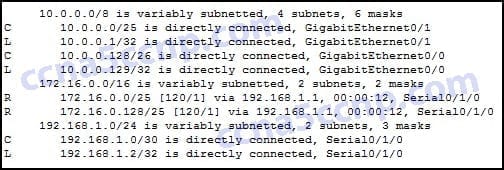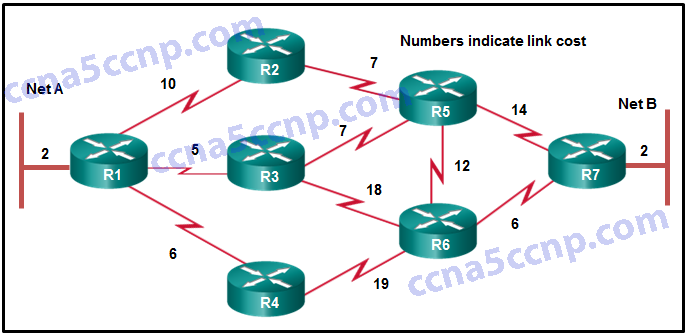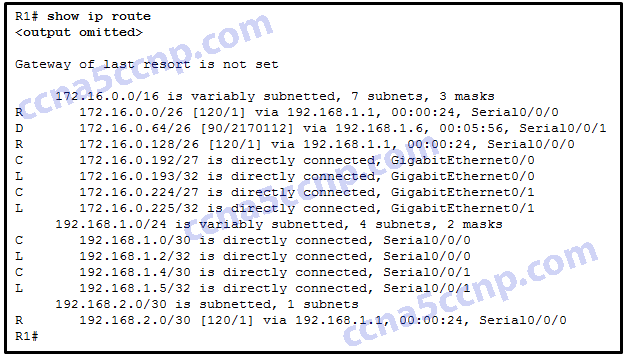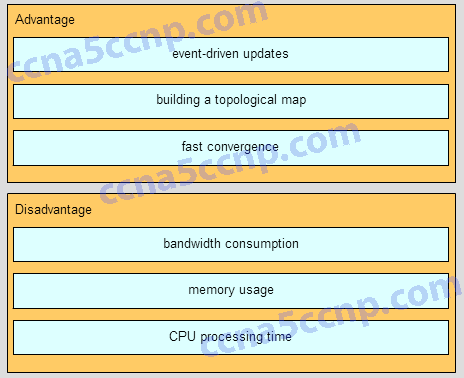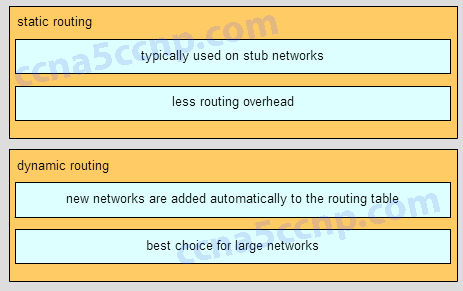Last Updated on April 3, 2018 by Admin
CCNA2 Chapter 7 Exam Answer v5.03 2016
From year to year, Cisco has updated many versions with difference questions. The latest version is version 6.0 in 2018. What is your version? It depends on your instructor creating your class. We recommend you to go thought all version if you are not clear. While you take online test with netacad.com, You may get random questions from all version. Each version have 1 to 10 different questions or more. After you review all questions, You should practice with our online test system by go to "Online Test" link below.
-
What two tasks do dynamic routing protocols perform? (Choose two.)
- discover hosts
- update and maintain routing tables
- propagate host default gateways
- network discovery
- assign IP addressing
-
What is a disadvantage of using dynamic routing protocols?
- They are only suitable for simple topologies.
- Their configuration complexity increases as the size of the network grows.
- They send messages about network status insecurely across networks by default.
- They require administrator intervention when the pathway of traffic changes.
-
Which dynamic routing protocol was developed as an exterior gateway protocol to interconnect different Internet providers?
- BGP
- EIGRP
- OSPF
- RIP
-
Which two statements are true regarding classless routing protocols? (Choose two.)
- sends subnet mask information in routing updates
- sends complete routing table update to all neighbors
- is supported by RIP version 1
- allows for use of both 192.168.1.0/30 and 192.168.1.16/28 subnets in the same topology
- reduces the amount of address space available in an organization
-
An OSPF enabled router is processing learned routes to select best paths to reach a destination network. What is the OSPF algorithm evaluating as the metric?
- The amount of packet delivery time and slowest bandwidth.
- The number of hops along the routing path.
- The amount of traffic and probability of failure of links.
- The cumulative bandwidth that is used along the routing path.
-
After a network topology change occurs, which distance vector routing protocol can send an update message directly to a single neighboring router without unnecessarily notifying other routers?
- IS-IS
- RIPv2
- EIGRP
- OSPF
- RIPv1
-
What is the purpose of the passive-interface command?
- allows a routing protocol to forward updates out an interface that is missing its IP address
- allows a router to send routing updates on an interface but not receive updates via that interface
- allows an interface to remain up without receiving keepalives
- allows interfaces to share IP addresses
- allows a router to receive routing updates on an interface but not send updates via that interface
-
Refer to the exhibit. Based on the partial output from the show ip route command, what two facts can be determined about the RIP routing protocol? (Choose two.)
- RIP version 2 is running on this router and its RIP neighbor.
- The metric to the network 172.16.0.0 is 120.
- RIP version 1 is running on this router and its RIP neighbor.
- The command no auto-summary has been used on the RIP neighbor router.
- RIP will advertise two networks to its neighbor.
-
While configuring RIPv2 on an enterprise network, an engineer enters the command network 192.168.10.0 into router configuration mode.
What is the result of entering this command?
- The interface of the 192.168.10.0 network is sending version 1 and version 2 updates.
- The interface of the 192.168.10.0 network is receiving version 1 and version 2 updates.
- The interface of the 192.168.10.0 network is sending only version 2 updates.
- The interface of the 192.168.10.0 network is sending RIP hello messages.
-
Refer to the exhibit. A network administrator has issued the exhibited commands in an attempt to activate RIPng on interface gig0/0. What is causing the console message that is shown after RIP is enabled?
- Interface gig0/0 is shutdown.
- Interface gig0/0 does not have a valid IPv6 address.
- IPv6 unicast routing has not been enabled on this router.
- IPv6 is not supported on this IOS.
-
Refer to the exhibit. OSPF is used in the network. Which path will be chosen by OSPF to send data packets from Net A to Net B?
- R1, R2, R5, R7
- R1, R3, R5, R7
- R1, R3, R6, R7
- R1, R4, R6, R7
- R1, R3, R5, R6, R7
-
Which two events will trigger the sending of a link-state packet by a link-state routing protocol? (Choose two.)
- the router update timer expiring
- a link to a neighbor router has become congested
- a change in the topology
- the initial startup of the routing protocol process
- the requirement to periodically flood link-state packets to all neighbors
-
Which two requirements are necessary before a router configured with a link-state routing protocol can build and send its link-state packets? (Choose two.)
- The router has determined the costs associated with its active links.
- The router has built its link-state database.
- The routing table has been refreshed.
- The router has established its adjacencies.
- The router has constructed an SPF tree.
-
When does a link-state router send LSPs to its neighbors?
- every 30 seconds
- immediately after receiving an LSP from neighbors with updates
- only when one of its interfaces goes up or down
- only when one of its neighbors requests an update
-
Which routing protocol uses link-state information to build a map of the topology for computing the best path to each destination network?
- OSPF
- EIGRP
- RIP
- RIPng
-
A destination route in the routing table is indicated with a code D. Which kind of route entry is this?
- a static route
- a route used as the default gateway
- a network directly connected to a router interface
- a route dynamically learned through the EIGRP routing protocol
-
Refer to the exhibit. Which interface will be the exit interface to forward a data packet with the destination IP address 172.16.0.66?
- Serial0/0/0
- Serial0/0/1
- GigabitEthernet0/0
- GigabitEthernet0/1
-
Which two requirements are used to determine if a route can be considered as an ultimate route in a router’s routing table? (Choose two.)
- contain subnets
- be a default route
- contain an exit interface
- be a classful network entry
- contain a next-hop IP address
-
Which route is the best match for a packet entering a router with a destination address of 10.16.0.2?
- S 10.0.0.0/8 [1/0] via 192.168.0.2
- S 10.16.0.0/24 [1/0] via 192.168.0.9
- S 10.16.0.0/16 is directly connected, Ethernet 0/1
- S 10.0.0.0/16 is directly connected, Ethernet 0/0
-
Which type of route will require a router to perform a recursive lookup?
- an ultimate route that is using a next hop IP address on a router that is not using CEF
- a level 2 child route that is using an exit interface on a router that is not using CEF
- a level 1 network route that is using a next hop IP address on a router that is using CEF
- a parent route on a router that is using CEF
-
A router is configured to participate in multiple routing protocol: RIP, EIGRP, and OSPF. The router must send a packet to network 192.168.14.0. Which route will be used to forward the traffic?
- a 192.168.14.0 /26 route that is learned via RIP
- a 192.168.14.0 /24 route that is learned via EIGRP
- a 192.168.14.0 /25 route that is learned via OSPF
- a 192.168.14.0 /25 route that is learned via RIP
-
What is different between IPv6 routing table entries compared to IPv4 routing table entries?
- IPv6 routing tables include local route entries which IPv4 routing tables do not.
- By design IPv6 is classless so all routes are effectively level 1 ultimate routes.
- The selection of IPv6 routes is based on the shortest matching prefix, unlike IPv4 route selection which
- is based on the longest matching prefix.
- IPv6 does not use static routes to populate the routing table as used in IPv4.
-
Fill in the blank. Do not abbreviate.
When configuring RIPng, the default-information originate command instructs the router to propagate a static default route.
-
Match the features of link-state routing protocols to their advantages and disadvantages. (Not all options are used.)
- Question
- Answer
-
Match the characteristic to the corresponding type of routing. (Not all options are used.)
- Question
- Answer
From year to year, Cisco has updated many versions with difference questions. The latest version is version 6.0 in 2018. What is your version? It depends on your instructor creating your class. We recommend you to go thought all version if you are not clear. While you take online test with netacad.com, You may get random questions from all version. Each version have 1 to 10 different questions or more. After you review all questions, You should practice with our online test system by go to "Online Test" link below.
